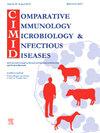Phenotypic and genotypic characterization of carbapenem encoding genes among carbapenem-resistant Gram-negative bacteria isolated from North Casablanca, Morocco
IF 2
3区 农林科学
Q4 IMMUNOLOGY
Comparative Immunology Microbiology and Infectious Diseases
Pub Date : 2025-08-19
DOI:10.1016/j.cimid.2025.102399
引用次数: 0
Abstract
Carbapenem resistance genes in Gram-negative bacteria (CR-GNB) are a major cause of critical infections and are considered an urgent public health concern. The present study aimed to describe the prevalence of CR-GNB and the dissemination of extended-spectrum beta-lactamase (ESBL) and carbapenemase genes in clinical isolates from Casablanca, Morocco. Firstly, the strains were collected and identified using phenotypic and biochemical methods, then the antibiotic susceptibility was evaluated by the disc diffusion assay to screen isolates resistant to carbapenems. Secondly, three traditional methods, the carbapenem inactivation method, the modified Hodge, and the in-house carba-NP, were performed to predict the carbapenemase production by the included strains. Finally, conventional PCR was utilized to validate and detect the carbapenemase- and ESBL-related genes. Concerning the results, out of the identified 122 strains, 48 were CR isolates, including 30 Klebsiella pneumoniae, 13 Escherichia coli, and 5 Pseudomonas aeruginosa. Furthermore, these strains presented a high level of resistance. Moreover, the prediction of carbapenemase production by the phenotypic methods showed variable results. Also, the PCR analysis revealed a high occurrence of β-lactamase (ESBL and carbapenemase) genes in the included clinical strains, and most strains harbored multiple resistance genes. Our findings suggest that the three existing methods have some limitations, and a validation study is still necessary for the carbapenemase diagnostics.
摩洛哥北卡萨布兰卡地区碳青霉烯耐药革兰氏阴性菌碳青霉烯编码基因的表型和基因型分析
革兰氏阴性菌(CR-GNB)中的碳青霉烯耐药基因是严重感染的主要原因,被认为是一个紧迫的公共卫生问题。本研究旨在描述CR-GNB在摩洛哥卡萨布兰卡临床分离株中的流行情况以及广谱β -内酰胺酶(ESBL)和碳青霉烯酶基因的传播。首先采用表型和生化方法对菌株进行鉴定,然后采用圆盘扩散法对其进行药敏评价,筛选对碳青霉烯类耐药菌株。其次,采用碳青霉烯类酶灭活法、改良的Hodge法和室内碳青霉烯类酶np法3种传统方法预测菌株碳青霉烯类酶的产量。最后,采用常规PCR方法对碳青霉烯酶和esbl相关基因进行验证和检测。结果鉴定出122株CR分离菌48株,其中肺炎克雷伯菌30株,大肠杆菌13株,铜绿假单胞菌5株。此外,这些菌株表现出高水平的抗性。此外,表型方法对碳青霉烯酶产量的预测结果也不尽相同。PCR分析结果显示,临床菌株中β-内酰胺酶(ESBL和碳青霉烯酶)基因的发生率较高,且大多数菌株含有多个耐药基因。我们的研究结果表明,现有的三种方法存在一定的局限性,对碳青霉烯酶的诊断仍需要进行验证研究。
本文章由计算机程序翻译,如有差异,请以英文原文为准。
求助全文
约1分钟内获得全文
求助全文
来源期刊
CiteScore
4.60
自引率
0.00%
发文量
102
审稿时长
40 days
期刊介绍:
Comparative Immunology, Microbiology & Infectious Diseases aims to respond to the concept of "One Medicine" and to provide a venue for scientific exchange. Based on the concept of "Comparative Medicine" interdisciplinary cooperation between specialists in human and animal medicine is of mutual interest and benefit. Therefore, there is need to combine the respective interest of physicians, veterinarians and other health professionals for comparative studies relevant to either human or animal medicine .
The journal is open to subjects of common interest related to the immunology, immunopathology, microbiology, parasitology and epidemiology of human and animal infectious diseases, especially zoonotic infections, and animal models of human infectious diseases. The role of environmental factors in disease emergence is emphasized. CIMID is mainly focusing on applied veterinary and human medicine rather than on fundamental experimental research.

 求助内容:
求助内容: 应助结果提醒方式:
应助结果提醒方式:


